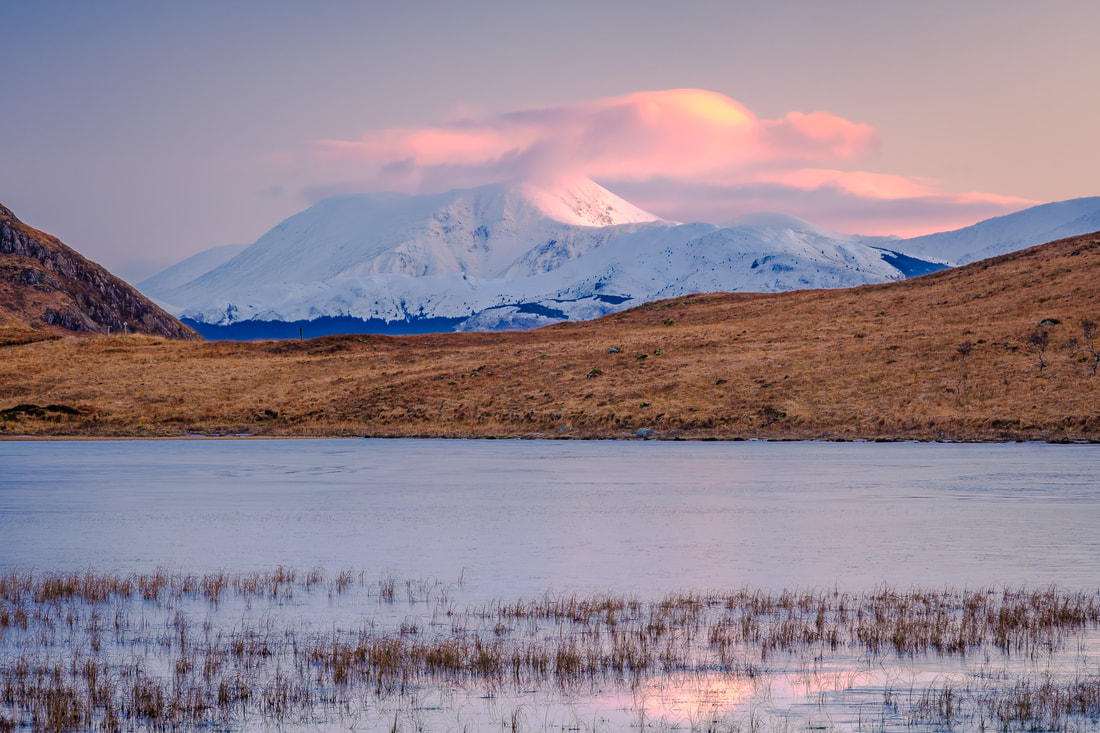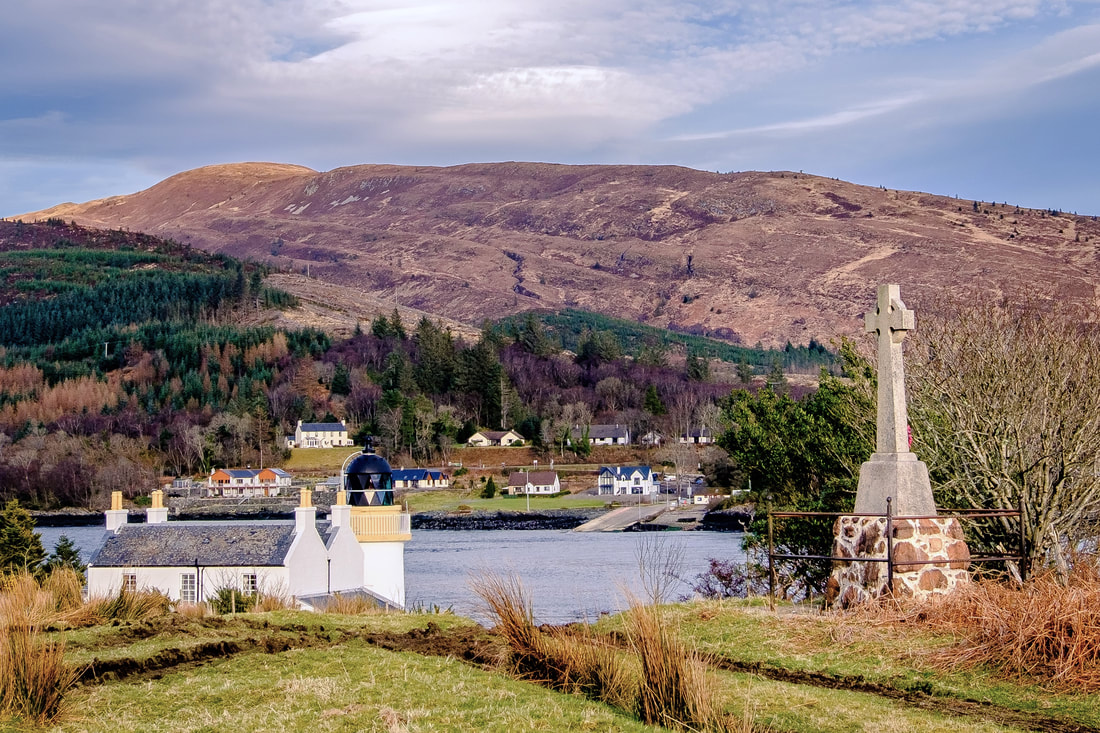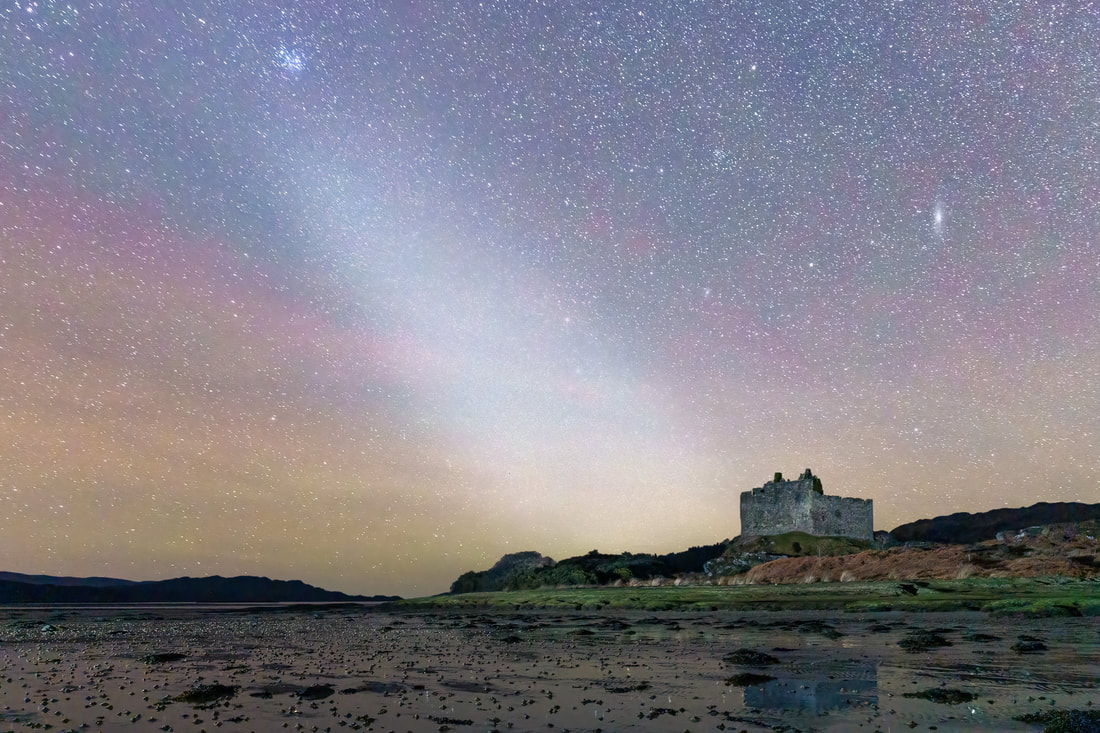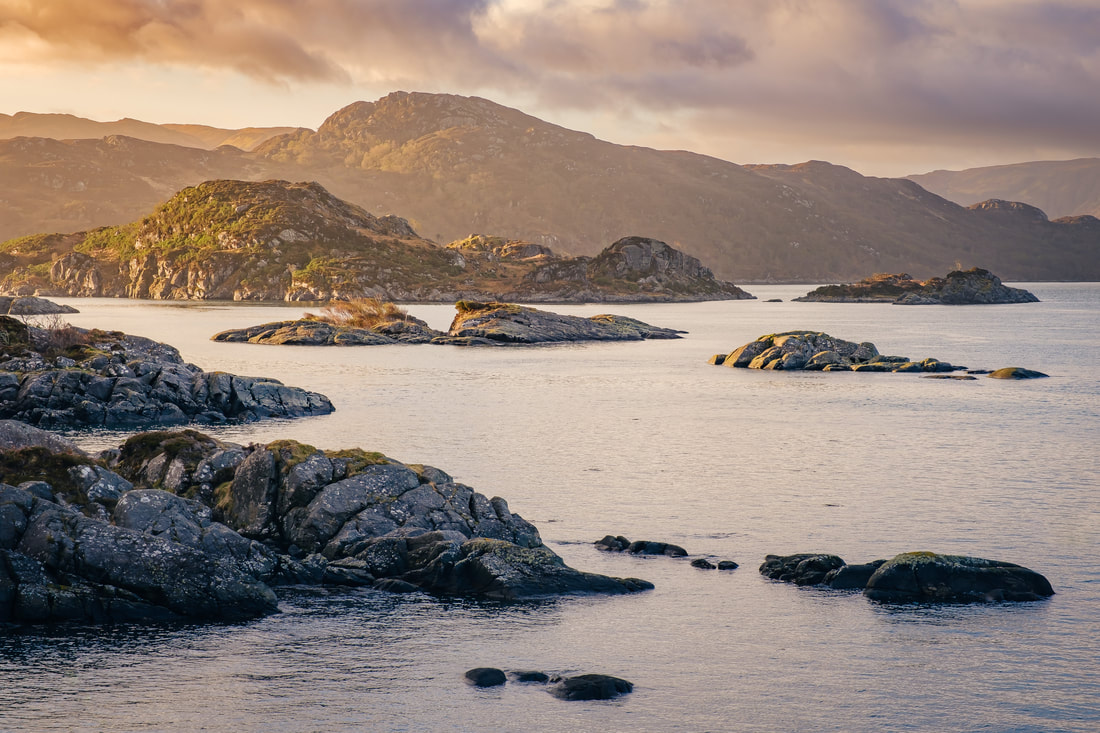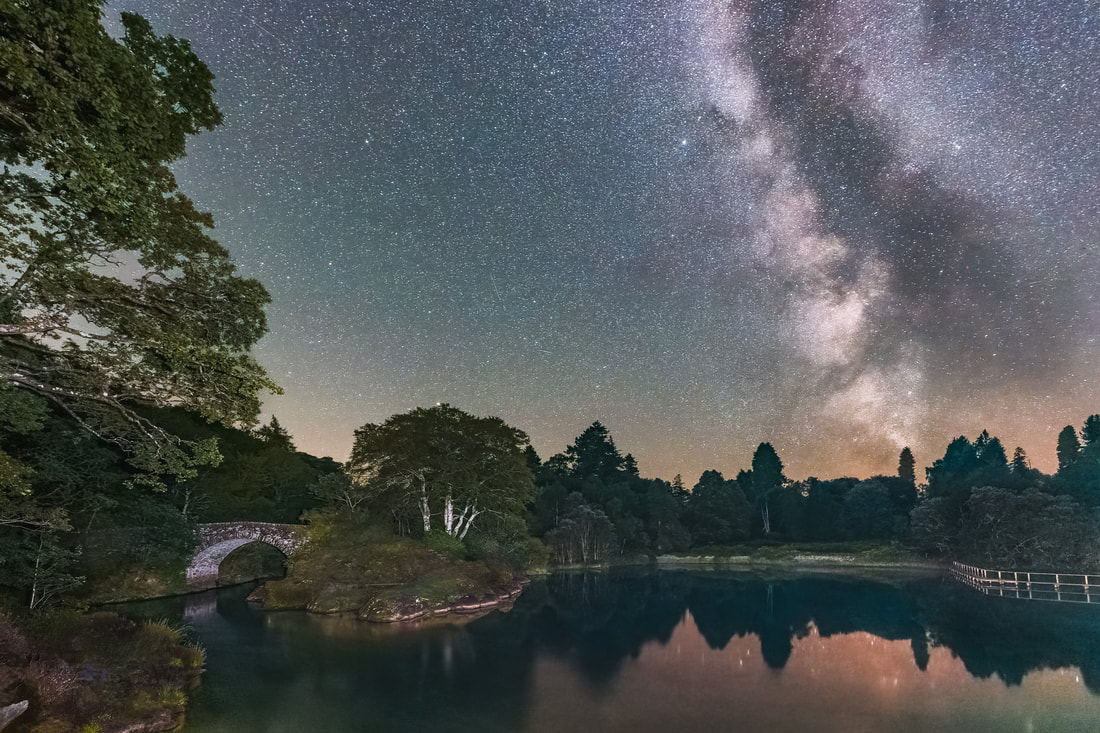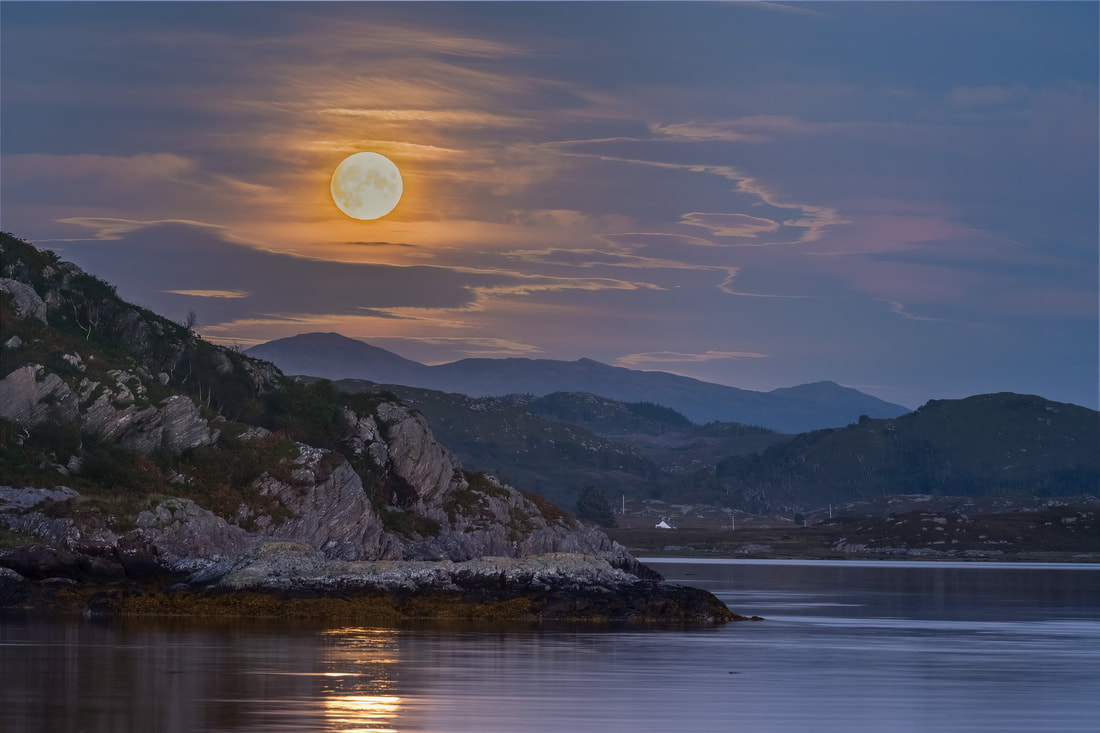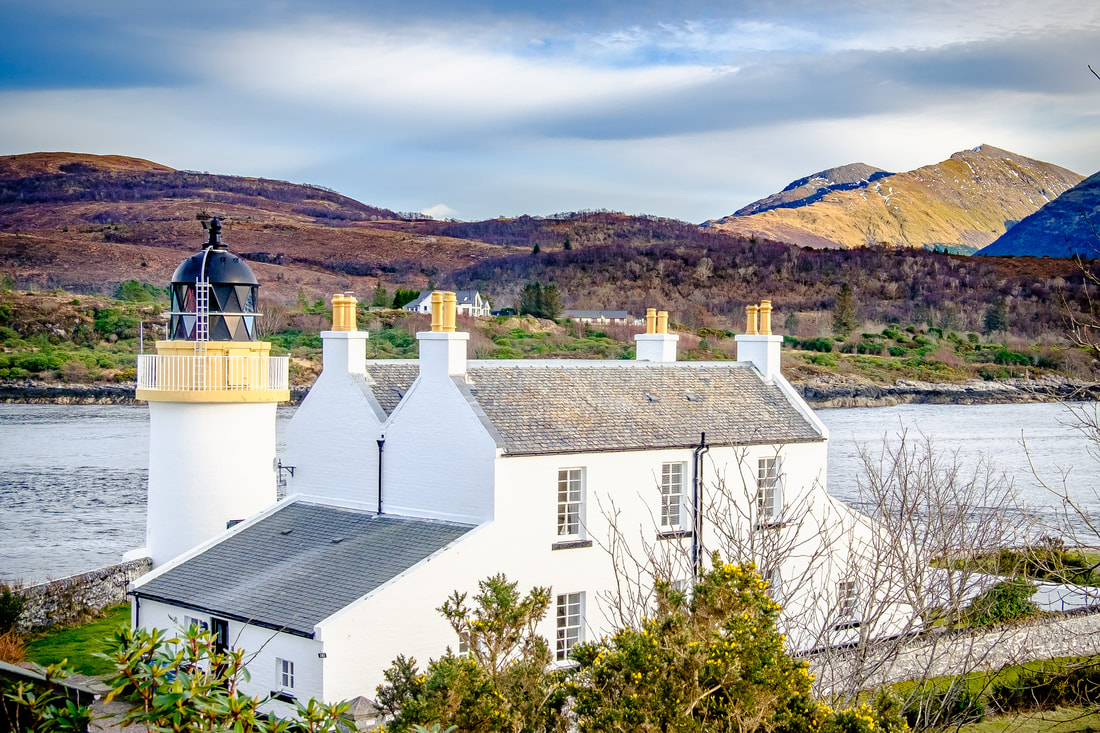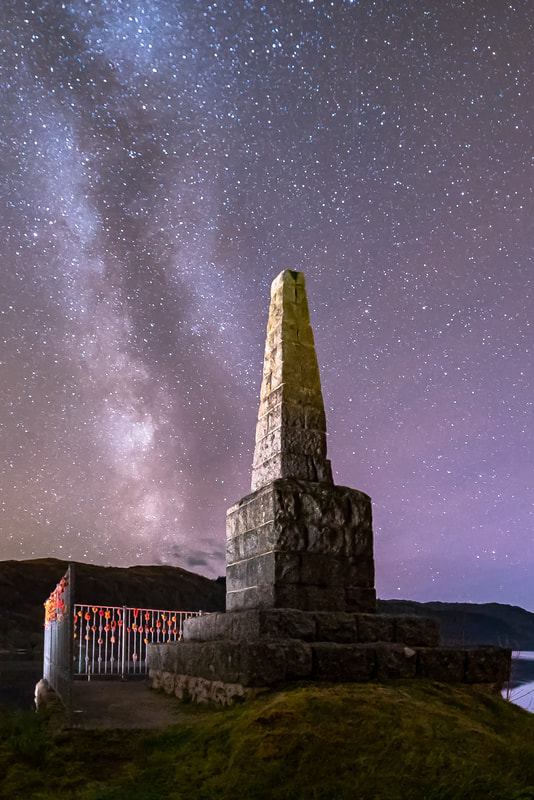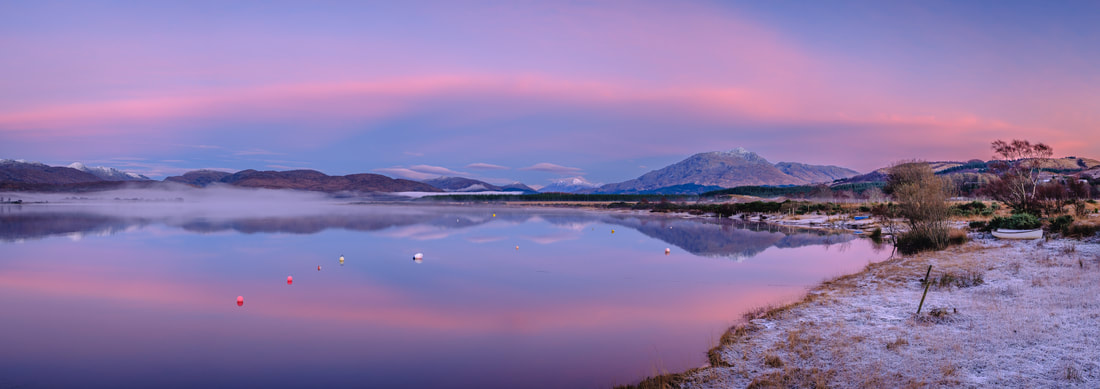|
Although Ben Nevis sits just to the east of Fort William, its height of 1,345 metres (4,413 feet) not only makes it the highest mountain in the British Isles, but also means that it is visible from a number of places on the Peninsula. One such place is Lochan Doire a' Bhraghaid and this is where I took the photograph below. It was taken on a cold January morning when the pink light from the Sun rising in the south-east was caught by the mountain’s south facing upper slopes and the clouds that covered what is an extremely elusive summit. A summit that, perhaps one day, I’ll be lucky enough to capture. The summit of Ben Nevis is notorious for unpredictable and often harsh weather conditions that are constantly influenced by North Atlantic weather systems. The mountain is in an area that experiences a significant amount of precipitation, averaging around 4,406 mm of rain annually. This, combined with the mountain's height, creates a perfect environment for cloud formation. The warm and moist air from the Atlantic meets its high peaks, resulting in the frequent presence of clouds. In fact, its summit is only visible for an average of 30 days per year, making it extremely elusive and therefore a challenge to photograph. However, I am hoping that with a little planning, patience, and persistence, I will eventually get the shot that I have in my mind’s eye.
Planning is the cornerstone of successful landscape photography and involves thorough research and preparation before heading out to a location. In this instance, the factors to consider are weather conditions, time of day, and the position of the sun. For the shot I’m after, I’m looking for an unobscured snow-covered summit with warm sunlight falling on the sides of Ben Nevis that are visible from Lochan Doire a' Bhraghaid some 17 miles to its southwest. This means that the shot needs to be taken on a morning during a cold and clear spell of weather in the months of December, January and potentially February because this is when the sun will be rising in the right place. I used various topographic maps and sun tracking apps to help me pick these months and various weather forecasts help me decide which days to go out on. Next up is patience. Nature does not always cooperate, and capturing the perfect shot often requires waiting for the right moment. The ideal lighting, weather conditions, and natural elements may not align immediately so I often find myself waiting an hour or more before I feel that the time is right to press the shutter button. On the morning I took the image above, I arrived before sunrise to see that the summit of Ben Nevis was clear. I therefore set up my tripod, framed the shot and waited in anticipation of Sun rising to bath it in a warm pink glow. However, it was not to be because a bank of cloud rolled in from the north and obscured the summit just as sunlight began to fall on the mountain. So finally, this is where persistence comes in, because it involves a commitment to returning to a location time and time again until the conditions are just right. In this instance, the lighting may have been perfect, but the weather did not cooperate. It was tantalisingly close, but that 1 in 12 chance of the summit being clear conspired against me and I didn’t quite get the shot I was looking for. In fact, I have returned to Lochan Doire a' Bhraghaid a few times since to capture that “elusive peak”, only to be met with no success. Never mind though. The thrill of landscape photography is often to do with the “chase” and when the conditions eventually do align, the resulting image will be more than enough reward for all the planning, patience, and persistence. Until then, I look forward to the day when I can share the image that I have in my mind’s eye with you.
0 Comments
I wonder how often folk have driven past the Ardgour War Memorial and never paid it much attention. This was certainly the case for me, having passed it countless times on my way to and from the Corran Ferry, until one day when I found myself with some spare time at the marshalling area on the Ardgour side of the Corran Narrows. After deciding to go for a quick walk, I found myself up on a bank just south of the lighthouse, standing beside the War Memorial and looking southwards at an expansive view of Loch Linnhe. While standing there, I spotted something that I would later learn played a small part in a huge project that is thought to have been key in bringing World War I to an end. The Ardgour War Memorial is typical of the many that you find scattered across the Highlands, consisting of a granite Celtic cross and plinth mounted on a base of what seems to be made of local stone. Whilst here, I took a moment to stand by it with my eye drawn to the wreath of red poppies that had been laid at the base of the cross and to the words inscribed on the plinth beneath it: IN MEMORIAM PARISH OF ARDGOUR THE GREAT WAR 1914-18 _____ DO'N GHINEALACH A RINN ÌOBAIRT SADH FHUILING CRUADAL, S A SHEALBHAICH BUAIDH _____ TO THE GENERATION WHICH BORE THE SACRIFICES AND BY SHARING IN THE HARDSHIPS, ACHIEVED VICTORY I then noticed that the Memorial’s stone base was sitting on what appeared to be a metal ring with several bolts protruding from it. I didn’t give them much thought at the time, but a day or two later, I couldn’t help wondering what they had been used for, so decided to try and found out.
The mines were being used in the North Sea Mine Barrage, a large minefield laid easterly from the Orkney Islands, right across the top of the North Sea to Norway with the aim of preventing the U-Boats based in Germany from making their way out into the Atlantic to attack the convoys that were bringing supplies from the United States to the British Isles.
I took these words for the image title from the seventh stanza of the poem, “For the Fallen” by Laurence Binyon, which reads:
“As the stars that shall be bright when we are dust, Moving in marches upon the heavenly plain, As the stars that are starry in the time of our darkness, To the end, to the end, they remain.” The poem is more commonly known for its third and fourth stanzas as they are often recited at Remembrance Day services as what is termed the "Ode of Remembrance", ending with the familiar words “We will remember them”. Despite the words of these two stanzas being extremely thought provoking, I find the words of the seventh stanza incredibly moving because there is such strong sense of poignancy to them. I guess that’s why I used them as the title for this image. I would never have thought that a seemingly innocuous slip on a wet rock at Ardtoe would have resulted in a debilitating injury requiring surgery, 4 months of immobilisation, 12 months of physiotherapy and a further 6-12 months of recovery time to get me back to a point where I can freely walk in and photograph the landscape here on the Peninsula. However, this was indeed the case, and I am thankful that I had my photography to use as the motivator to get active and aid my recovery. It also resulted in the creation of a collection of 72 images that portray the varying landscape and moods of the Peninsula throughout 2022. This blog contains 12 of these images, one for each month of the year, and I hope to share the remainder of them over the course of 2023. The BackstoryOn 6th July 2021, I slipped on some wet rocks at Ardtoe, dislocating my knee and tearing my patellar tendon in two. Following an operation to repair the damage, I found myself immobilised and in a knee brace until early November and unable to get out and do any photography. While laid up in the brace, I set myself the target of getting back out with the camera by the start of 2022 and the objective of taking 5 or 6 images each month that captured the varying landscape and moods of the Peninsula throughout the year. With limited mobility, especially at the start of the year, I had to think carefully about locations I could safely go that would provide me with opportunities to take the photographs that I had in mind. This was a bit of a challenge at first, but I found that this limitation helped me with my creativity. By the end of the year, I had visited enough locations and taken enough photographs to enable me to create a collection of 72 images, or six for each month to reasonably portray the Peninsula over the course of 2022. Twelve of these images, one for each month, are presented in this blog and I plan to share the rest of them over the course of the coming year in a new section on this website titled “A Year on the Peninsula”. As well as the collection of images, the project provided me with the motivation to get “out there” and get back into my photography and aid my recovery. When pulling these images together, I was certainly reminded of how far I have come since that day in January when I gingerly made my way down the jetty at Salen with the help of a crutch to take the first photograph in this collection. I still have a number of months left in my 18-24 month long recovery period and hopefully, as my ability to walk on uneven ground and also downhill improves, I’ll be able to range further afield and photograph locations that I have not been able to get to since that fateful day in July 2021. The ImagesAnticipation I - Loch Sunart, Salen Jetty, Ardnamurchan
I started the year with some early morning visits to the old jetty in Salen because in January, the sun rises well round to the south-east and is able to cast beautiful light and colours onto the waters of the bay and the jetty itself. On my final morning, the sun seemed to take an age to appear from behind the hills of Morvern, but it was well worth the wait. Distant Lighthouse I - Port na Carraidh, Ardnamurchan
Mid-February brought Storm Eunice along with its record-breaking winds and widespread disruption. The day after the Storm had passed, I headed out to Port na Carraidh at the western end of the Peninsula with the aim of photographing a distant view of the Lighthouse and after much searching I settled on this composition that used the stream on the sandy beach to lead the eye out to it. Tioram and the Zodiac - Castle Tioram, Dorlin, Moidart
In March, the Zodiac rises steeply from the horizon at dusk, making it a great time for spotting Zodiacal Light. Caused by light from the sun reflecting off a fog of tiny interplanetary dust particles that fill our inner Solar System, it shows as a faint triangular glow rising steeply from the western horizon just like in this image I took at Castle Tioram. Light on Risga - Loch Sunart, Glenborrodale, Ardnamurchan
This shot was taken on an April morning when I was driving back home from an overnight photo session out west. As I approached Glenborrodale, the first light of the day was falling on the island of Risga, the skerries around it and Carna behind it. A sight that was simply too beautiful to not stop and photograph. Caisteal nan Con I - Bagh Caisteal, Killundine, Morvern
Caisteal nan Con (Castle of Dogs), overlooks the Sound of Mull on the eastern coast of Morvern. I have passed it a few times on trips out to Drimnin and it has always caught my eye, so I decided to stop when passing it late on an evening in May and photograph just as cloud was rolling in from the west and catching the pinks from a setting sun. Day's End, Land's End - Ardnamurchan Lighthouse, Ardnamurchan
Three days after the longest day of the year, in late June, I was out at the lighthouse for its 25th anniversary of community ownership. The day had started with wind and rain but the afternoon cleared and I decided to capture the day’s end a good few hours after the anniversary celebrations ended. The sun set in the northwest shortly after 10:00 pm. Sundown Blues II - Sailean Dubh, Ardtoe, Ardnamurchan
A “must do” thing to do in July is to watch the sun set directly behind the Small Isles of Eigg and Rùm from the headland on the western side of the beach at Ardtoe. I had spent a very peaceful time doing just that in the couple of hours before I took this image of the blues of the emerging blue hour mixing with the golds of sunset. Return of the Stars - The House Pool, River Shiel, Blain, Moidart
In August, the lengthening nights mean the return of stars and up until early October, you can marvel at the sight of the Milky Way filling the sky with a cloudy band of stars. This image shows it soaring above the House Pool on the River Shiel on a night in late August when I must have seen around a dozen shooting stars from the Perseid meteor shower. Harvest Moon Reflections - Ardtoe Pier, Kentra Bay, Ardnamurchan
In September, the full Moon rises in the southeast and if you watch it from Ardtoe Pier at the western end of Kentra Bay, it will appear above a distant Ben Resipole and cast reflections onto the water in the bay as it does so. In 2022, it was the nearest full Moon to the autumnal equinox, earning it the title of 'Harvest Moon'. Lilac Dawn - Loch a' Choire, Kingairloch, Ardgour
Loch a’ Choire is at the heart of Kingairloch Estate and in October the Sun rises in line with its east facing entrance and can create some beautifully vibrant sunrises there. I had hoped to capture one of these sunrises on the morning I was there, but haze and cloud on the horizon subdued it and instead created some lovely lilac hues on the loch’s surface and in the sky above it. Two Bridges - River Shiel, Blain, Moidart
The 2.5-mile-long River Shiel flows from Loch Shiel to the sea and forms part of the boundary between Moidart and Ardnamurchan. It can be crossed by either of the two bridges shown in this image which was taken on a November afternoon when the light bathed the autumn-coloured trees on the Moidart side it. Ben Resipole can be seen in the distance. A Year Ends - Kentra Bay, Gobshealach, Ardnamurchan
Early December brought clear blue skies and sub-zero temperatures which were followed by two weeks of milder weather, wind and heavy rain. Fortunately, this broke for a little while on New Year’s Eve to allow me to capture dusk falling on the mouth of Kentra Bay as the end of the year approached. The Small Isles of Muck, Eigg and Rùm are in the orange glow on the horizon. As we move away from the Autumn Equinox and towards the Winter Solstice it seems to me that, along with the days getting shorter and colder, the evening skies are getting brighter and bolder. We often get brooding skies, with the oranges, pinks and reds from the setting sun breaking up the greys, blues and purples of clearing storm clouds to produce dramatic scenes such as one I witnessed at Castle Tioram on a late-November afternoon and shown the image below. This makes me beg the question: Are late autumn and winter sunsets better than those we get at other times of the year? Well, it turns out that scientific studies have confirmed this to be the case and they have discovered the reasons why Scientific researchers have found that the peak sunset season is from November through to February and that this is down to a combination three things. These are the type and quantity of the cloud cover, cooler air temperatures and how the Earth is tilted towards the sun at this time of the year. Contrary to what you might think, we need clouds for a good sunset and they have to be the right kind of clouds. If they are too low down on the horizon, they will block out the Sun’s rays and prevent a sunset. Instead, we need mid to high level clouds that will refract the sunlight and give us those beautiful sunset colours. This happens more in autumn and winter because the weather patterns we get then tend to bring mid and high-level altocumulus, altostratus and cirrus clouds. The cooler temperatures mean that the air is less humid and that there is less water vapour to capture dust particles that are in the air and create the haze which is often a feature of the summer months. When present, this haze scatters sunlight and reduces its intensity. So, in autumn and winter, the lower humidity means that the air is clearer and we see the colours produced by the setting sun in all their intensity. Finally, as we approach the winter solstice, the North Pole gets tilted further away from the sun, lengthening the time taken for the sun to set. This, in turn, means that the sunset colours last longer than at the equinoxes, for example, when the sun sinks very quickly towards the horizon at a 90-degree angle. The result is that we have more time to enjoy the sunset colours and the sunset colours have more time to make an impact on us. Despite all of these variables, predicting sunsets doesn’t have to be hard. All you need to do is keep an eye out for the following key indicators:
Mid to high-level clouds (2km and above) Cloud coverage - 30 to 70 percent Humidity - low but not too low Clean air Prior rainfall - no less than 2 to 6 hours before Wind speed - low or non-existent There are many online forecasts for these weather conditions and the one I refer to most is windy.com. So why don’t you have a go at predicting a sunset and head west at what you think might be a good time. You never know, you may be well rewarded for your efforts! With some time to spare after travelling back across the Corran Narrows on the ferry, I found myself up at the Ardgour War Memorial looking at signs of something that had gone before which had been a small part of a huge military project that is thought to have played a key role in bringing World War I to an end …. Time on my HandsLast week, I found myself with an unexpected hour or so to spare at Corran Point, so decided to go for a walk and find the Ardgour War Memorial, which is located up on a bank just south of the lighthouse and above the road. The main reason for doing this was to scout out the location in advance of me going there at some point after dark to photograph the Memorial under the stars. This is something that I do when preparing for most of my night shots as it is so much easier to figure out a composition in daylight than it is in the pitch dark. Having walked from the Corran Ferry, I reached the bend in the road by the Lighthouse and followed a track up into a field beyond a metal gate. I found the War Memorial at the top of a bank overlooking Loch Linnhe, with expansive views all the way down its full length to the south. The Memorial itself is typical of the many that you find scattered across the Highlands, consisting of a granite Celtic cross and plinth mounted on a base of what seemed to be made of local stone.
Gradually, I began thinking ahead to my future shot of the War Memorial under the stars and, eventually, I began looking at different shot angles of the Memorial to see if I could find some compositions that might work for the photograph that I had in mind. My plan is to take it later in the year when the Milky Way will be at its best, with its cloudy core above the horizon in the south to south-west sky. My aim is to produce something similar to these two shots that I’ve taken of the Strontian and Moidart war memorials in previous years. While doing this, I noticed that the Memorial’s stone base was sitting on what appeared to be a metal ring with several bolts protruding from it. You can see the metal ring and bolts in the picture below and the more that I thought about them, the more I couldn’t help wondering what they had been used for. Playing on My MindThis played on my mind for a day or two, leading me to do a bit of research to find out more about them. After looking at a few sources, I found some information in the Highland Historic Environment Record, that suggested that a gun battery was built on that spot in 1917, to provide protection for the United States ships unloading naval mines at Corpach that were then transported in smaller boats through the Caledonian Canal to the US Naval Base at Inverness. Further research uncovered a report titled “The Built Heritage of the First World War in Scotland” that was commissioned by Historic Scotland which confirms that the gun battery was built there and that it comprised two 15-pdr guns and one 7.5-inch howitzer bolted down onto steel rings called holdfasts, which were set into plain concrete slabs. It turns out that the War Memorial was built on one of these concrete slabs and the steel ring at its base is one of these holdfasts. The Imperial War Museum does have a photograph of the gun battery which was taken in 1918 and shows the Royal Marine Gun Crews manning the guns. In it, you can see that there is no parapet around the guns and that the ammunition for them was stored in wooden lockers close by. I’ve asked the Imperial War Museum for a licence to publish this photograph and hope to be able to share it with you at some point. A Small Part of a Big PictureAnother question came to my mind while I was researching all this – Why was the United States Navy shipping naval mines to Corpach and then transporting them up the Caledonian Canal to Inverness? Well, the answer is that the mines were being used in the North Sea Mine Barrage which was a large minefield laid easterly from the Orkney Islands, right across the top of the North Sea to Norway with the aim of preventing the U-Boats making their way from their bases in Germany and out into the Atlantic to attack the convoys that were bringing supplies from the United States to the British Isles. Laying this mine barrage was a huge undertaking and until World War II, it was the largest ever laid. It spanned the entire 230-mile width of the North Sea from Orkney and Norway and was between 15 to 35 miles wide. The Allied Forces began laying the mines in June 1918 and within a matter of a few months they had laid just over 70,000 of them at a total cost of just over £1bn in today’s money. The barrage was considered to be a great success and is credited with the destruction or damage of up to 21 U-Boats, but probably its greater effect was in shattering the morale of German submarine crews, thus helping to bring about the revolt of German seamen that marked the beginning of the defeat of Germany in World War I. Hidden HistorySo there you have it, a tiny little bit of history hidden beneath the Ardgour War Memorial in the form of a steel ring and some bolts giving a small clue of something that went before. I would never have thought that these incongruous bolts would have been part of what today would be the equivalent of a £1bn military project that is thought to have played a key part in bringing World War I to an end. A war that left more than 16 million people dead and also helped to spread one of the world’s deadliest global pandemics, the Spanish flu epidemic of 1918, which killed an estimated 20 to 50 million people. Poignant, very poignant indeed.
We’re coming to the end of this winter. One during which we had the coldest January since 2010. One of snow and of cold and clear weather and one that has been productive from a photographic perspective. See some of the images I’ve captured and find out a bit about the story behind them…. How Do You Cope with all the Snow?We are fast approaching the start of Meteorological Spring (March, April and May) and also the end of my fifth winter since moving to the Peninsulas. There is a noticeable difference in the hours of daylight as the nights shorten and it will not be long before the landscape begins to spring back into life. I find myself thinking back on the winter months of December, January and February; and also a question I’m often asked by people visiting – “How do you cope with all the snow in winter?” Why this question gets asked always intrigues me. It seems to always happen when standing on the decking outside my studio looking at Loch Sunart and all the hills that surround it. Could it be because this remote and rugged landscape looks foreboding? Could it be because we are well north of where most people live? Who knows? Well, whatever it is, my answer is always the same - “It’s never a problem here as we don’t get that much snow and when we do get it, it is usually only high up on the hills. In fact, if the snow does fall down here at sea level, it only lasts a day or two at the very most and I guess that being on a bit of land that sticks out into the sea on the west coast means that the Gulf Stream keeps the temperatures up”. This is indeed true and it is complete contrast to the snowy winters I experienced when growing up on the east side of Scotland when, in the days without central heating, thick frost would form on the inside of the windows and we’d need to scrape a little hole in it to reveal what was outside. I do miss “proper” winters like that, but looking back over the last few months, it certainly feels as if we’ve had one this time. In fact, we’ve just had our coldest January since 2010, with the average temperature recording in Scotland being 0.6°C while my weather station here at Resipole recorded an average of 2.9°C. The strong northerly air flow that brought the low temperatures also brought substantial sunshine with it and plenty of cold, crisp and clear days on which I just had to get out with the camera. First Snow and Winter InspirationLooking back through my images from the last few months reminded me that this “proper” winter weather was not just limited to January. Indeed, we saw our first snow at the end of November while having a staycation at Kingairloch Estate over on the east side of the Peninsulas. We woke up on a morning towards the end of our week away to see snow on the distant high peaks of Glencoe and the Mamores. This prompted a drive up the shore of Loch Linnhe to get a closer look. The snow-capped mountains looked lovely under the clear blue sky and we just had to stop at Lochan Doire a' Bhraghaid to take in the view. From there you get a fantastic view of Ben Nevis because you can see it through a gap in the hills above Inversanda. While there, I took this shot of the snow-covered slopes of Ben Nevis, some 17 miles to the north and made a mental note to myself to come back at some point and capture it when it had the first light of a winter day on it. Searching for Some LightThis first of the winter snow on the hills lasted for just over a week, but before it disappeared, I headed to West Ardnamurchan and up to a spot high on the slopes of Beinn Bhuidhe above Glenmore. It’s a great place to capture panoramic views of Loch Sunart or use a long lens to not only pick out elements of the high hills of Morvern on the other side of Loch Sunart, but also of Loch Teacuis, which cuts its way southwards into them. Unfortunately, I always seem to time my visits to the slopes of Beinn Bhuidhe on days when the light does not want to do what I need it to do. I’ve lost count of the number of times I’ve left Resipole under promising looking skies only to arrive at my spot and find thick cloud and no light on the landscape. I thought that this time was going to be another like that because thick cloud greeted me on my arrival. As I followed the path up to Beinn Bhuidhe, I kept looking at the cloud filled sky in the hope that it would clear a little and let through some light, but it didn’t. Undeterred, I set up at my chosen spot and sat for about an hour, sheltering as best I could from the biting easterly wind, while looking through the long-lens I’d fitted to the camera in search of some compositions that might work if the light did appear. I had almost given up hope, but in the few minutes before the sun was due to dip below the hills to the south-west, a small gap appeared to let a patch of light fall on the snow-capped peak of Beinn Iadain, one of the high peaks of Morvern. The resulting image shows the peak of Ben Iadain sporting a crown of golden light with the north facing slopes of Beinn Ghormaig, the Isle Carna and the Isle of Risga sitting in front of it. An Afternoon of SerendipityThankfully, not all my shots are so hard won and occasionally good fortune smiles on me. In early December, a few weeks after my time on Beinn Bhuidhe, I had a batch of Christmas orders to take to the Post Office in Acharacle and while packing them all into the car, I could not help but notice some hints of colour appearing in the sky to the west. It looked promising, so I decided to take my camera gear with me just in case. I sure wasn’t disappointed with what unfolded. As I drove down into the village, I could see the mist beginning to form in the air above Loch Shiel, so instead of going straight to the Post Office, I took the short detour down to the jetty in village to check out the conditions on the loch. As I stood on the jetty, I watched the pinks and purples of a winter sunset intensify while mist rolled down the loch and I couldn’t help but feel an overwhelming sense of calm, as well as whole load of good fortune about my decision to take my camera gear with me. I was there for well over an hour, photographing scenes in different directions and under different light conditions before deciding that I really needed to get to the Post Office before it closed. Both jobs done. Parcels posted and a number of “keepers” captured including this panoramic image of the sunset colours at their peak. A Plan Comes TogetherFinding myself in January and in a new year, my mind was still set on capturing the shot of the first light of the day on the snow covered peak of Ben Nevis. The shot that I had thought of when I saw the first snow of this winter on the hills back in November. With clouds usually covering its summit for nearly 80% of the winter months, photographing Ben Nevis sure turned out to be a bit of a wating game. There needed to be a clear morning during a spell of the weather cold enough to put snow on the Ben and freeze the surface of Lochan Doire a' Bhraghaid. Finally, at the start of the second week in January, the conditions seemed very promising and I headed up into the hills above Inversanda for sunrise in the hope that I’d get the shot I was looking for. Setting up in the dark, I couldn’t see if Ben Nevis was clear of cloud, but the moon and stars above my head suggested that it could be. As I waited for the first light of what was a very cold January morning to appear, the mountain began to emerge from the darkness and it looked as if my luck was in. Eventually, the first light of the day shone on its south facing upper slopes and there was just enough cloud to enhance the pink of the sunrise which, even at a distance of 17 miles, was reflected back onto the frozen surface of the lochan. I love it when a plan comes together. Time for a Plan BThe last week in January brought a few days of very heavy snowfall which, very unusually left a couple of inches of the white stuff all the way down to the seashore. Equally unusual were day and night-time temperatures so low that the snow at sea level did not disappear. As I watched successive tides wash fresh falls of snow from the loch shore, I thought that an image of snow lying on a sandy beach all the way down to the water would be worth capturing and that the beach at Ardtoe would be a great place to do it. With this in mind, I awoke early on a morning after heavy overnight snow had been forecast. On opening the curtains to a freshly snow-covered landscape, I decided to head out to Ardtoe. With much anticipation, I left the house but as I drove closer and closer to my destination the clear skies became more and more obscured by mist. This is not unusual because the low ground around Loch Shiel often cradles mist on cold and still winter mornings. So undeterred, I continued my journey to the beach as experience suggested that it would be clear there. However, it was not to be and I was greeted by a snow-covered beach shrouded in thick mist. The more I waited for the mist to clear, the thicker and thicker it seemed to become, so I eventually decided to head home. On the drive back through a beautiful snow-covered landscape, I thought that the conditions were too good to submit to failure and began racking my brains to figure out a place where a combination of misty conditions and fresh snow fall could work together. I eventually decided to take a small detour to the old bridge over the River Shiel at Blain to see what it was like there. When I arrived, I was not disappointed. The scene was stunning with all the trees covered in the freshly fallen snow and some beautiful light fighting its way through the mist behind the bridge. After an extremely productive half hour, I left with a few images, including this one of the bridge, with the river beneath it coloured by golden light fighting to break through the mist behind it. Thank heavens for a little local knowledge and for figuring out a Plan B. A Winter I Will RememberIt’s been a winter just like the ones I remember from my childhood. I’ll remember it not only for its snow and its cold, clear days but also for it being a winter that has given me an extremely productive time for my photography. The images I’ve included in this blog are just a small sample of those that I’ve captured and if you’d like to see more, you can find the in the Recent Images Gallery on this website. I hope you enjoy them.
|
AuthorHi, Archives
July 2024
Categories
All
|
Steven Marshall Photography, Rockpool House, Resipole, Strontian, Acharacle, PH36 4HX
Telephone: 01967 431 335 | Mobile: 07585 910 058 | Email: [email protected]
Telephone: 01967 431 335 | Mobile: 07585 910 058 | Email: [email protected]
All Images & Text Copyright © 2024 - Steven Marshall - All Rights Reserved

